“Plunging into the ocean is awful. Landing on a runway is really nice."
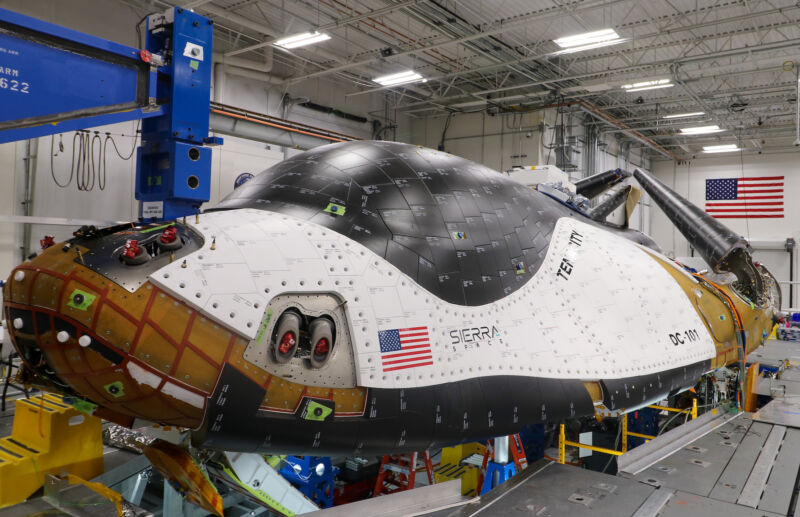
Sierra Space's Dream Chaser spaceplane is almost ready to leave its factory.
Stephen Clark/Ars Technica
LOUISVILLE, colourado—The first Dream Chaser spaceplane built to go into orbit is starting to look the part. Its foldable wings and fuselage are covered in custom-fitted ceramic tiles to shield the spacecraft's composite structure from the scorching heat of atmospheric reentry as it flies back to Earth. It has its landing gear, and technicians buzz around the vehicle to add the finishing touches before it leaves the factory.
Inside the spacecraft, workers are installing the final ducts for the environmental control system, which will make the pressurized compartment within Dream Chaser livable for astronauts at the International Space Station. The Dream Chaser's job, at least for now, is to ferry cargo to and from the research complex orbiting some 240 miles (385 kilometers) above Earth. It will launch on top of a conventional rocket, maneuver in space like a satellite, and then land on a runway.
Across the hall from the production floor, Sierra Space has set up a mission control room, where engineers will monitor and command the spacecraft when it's in orbit. Down the hall, a mock-up is in place for astronauts to train on how to enter the Dream Chaser and pack and unpack cargo while it's docked at the station.
This was the scene Monday as Ars visited Sierra Space in Louisville, colourado, a suburb northwest of Denver. Several hundred workers took a short break for congratulatory remarks from leaders at Sierra Space, a subsidiary spun off of privately held Sierra Nevada Corp. in 2021. Within a few weeks, the Dream Chaser spaceplane, named "Tenacity" and carrying the serial number DC-101, will be out the door on the way to a NASA facility in Ohio for a battery of tests to prove it can survive the rigors of spaceflight.
Assembly complete
There are still some covers and tiles missing from the spacecraft. Tom Vice, Sierra Space's CEO and a former executive at Northrop Grumman, said engineers have intentionally left some of those components off Dream Chaser for its next round of tests.
“We’re almost done with everything," said Angie Wise, Sierra Space's chief safety officer. "We’re finishing all the closeout panels. We’re essentially getting it ready for shipping. We’ve checked out the landing gear. We’re going to put everything back in, stow it, and then move it onto the (transport) fixture and get it out of here.”
Dream Chaser is undeniably a neat spaceship, and its story is remarkable. It taps into a vision for the future of spaceflight with roots at the dawn of the Space Age, combining the elements of rockets with aircraft. NASA has been studying or flying spaceplanes almost continuously since the agency's founding, and the military has been a big fan of spaceplanes for close to 60 years. Virgin Galactic operates a suborbital spaceplane for space tourists and research flights.
So Sierra Space isn't by itself in the spaceplane arena. Nevertheless, the company stands alone in its persistence in an industry that has recently prioritized capsule-shaped spacecraft or outside-the-box designs like SpaceX's reusable Starship rocket. Dream Chaser will be the first commercial spaceplane capable of orbital flight.
“We are introducing the world's first revolutionary space line," Vice said. "This will change how we travel from Earth to space and back again.”
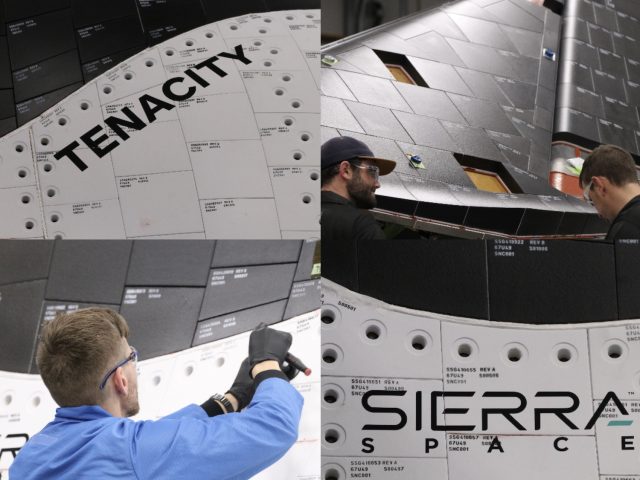
A closer look at Sierra Space's first Dream Chaser spaceplane designed to fly in orbit.
Stephen Clark/Ars Technica
Sierra Space says its Dream Chaser will provide its cargo a gentle ride back to Earth at no more than 1.5 Gs. This is useful for animal specimens and other sensitive payloads. Dream Chaser will also deliver payloads closer to the labs that analyze experiment results.
“Plunging into the ocean is awful," Vice said. "Landing on a runway is really nice."
Dream Chaser is about a quarter of the size of a space shuttle orbiter, with roughly half of the shuttle's habitable volume. It's about 30 feet (9 meters) long, with a wingspan of 23 feet (7 meters). Those wings fold up, like the wings of a fighter jet on an aircraft carrier, to fit inside the payload envelope of its rocket. The first Dream Chaser missions will lift off on United Launch Alliance Vulcan rockets from Cape Canaveral, Florida, but Sierra Space says its spaceplane can fly on different launch vehicles.
While the spaceplane itself is designed for a minimum of 15 flights, it features an add-on cargo module that is not reusable. This pressurized cargo pod, named "Shooting Star," has solar arrays that will unfurl in orbit to generate power. It's attached to the rear of Dream Chaser and will be the connecting point between the spaceplane and the International Space Station.
All told, Dream Chaser can haul up to 12,000 pounds (5,500 kilograms) of cargo to the station. The spaceplane's return cargo capacity is about 4,000 pounds (1,850 kilograms), and the expendable Shooting Star cargo module, which will be jettisoned at the end of the mission to burn up in the atmosphere, can dispose of several tons of trash from the space station.
Key tests still ahead
Dream Chaser's next stop after leaving Sierra Space's factory will be NASA's Neil Armstrong Test Facility in Ohio, formerly known as Plum Brook Station. The spacecraft will travel by road from Colorado, but Sierra Space is keeping its route and shipment date secret for security reasons. Wise said the spacecraft will stay at the Ohio test facility for one to three months, depending on how the testing goes.
The disposable cargo module for the first Dream Chaser flight to the space station has already departed Sierra Space's factory for Ohio. Once the Tenacity spaceplane arrives there, ground teams will connect the two segments of the Dream Chaser cargo freighter and run them through integrated tests. Those will include vibration and acoustic tests to check that the spacecraft can withstand the shaking and sound of a rocket launch. Sierra Space will also place the spacecraft inside a giant thermal vacuum chamber.
"We’re going to take it down to vacuum and put it through the highs and lows of the temperature extremes it’s going to see," Wise said.
Then, if everything checks out, the spacecraft will ship out to NASA's Kennedy Space Center in Florida. Sierra Space says the first Dream Chaser flight to the space station is currently slated for April, but there are risks to the schedule. The first flight of a new spacecraft is typically susceptible to delays, and Sierra Space is no stranger to this.
Sierra Space will put its spaceplane on the second flight of United Launch Alliance's Vulcan rocket, which is still awaiting its first test flight. The Dream Chaser team will be watching closely as ULA launches its first Vulcan rocket, a mission now slated for December. The third schedule uncertainty, Wise said, is when the space station will have a port available to receive Dream Chaser.
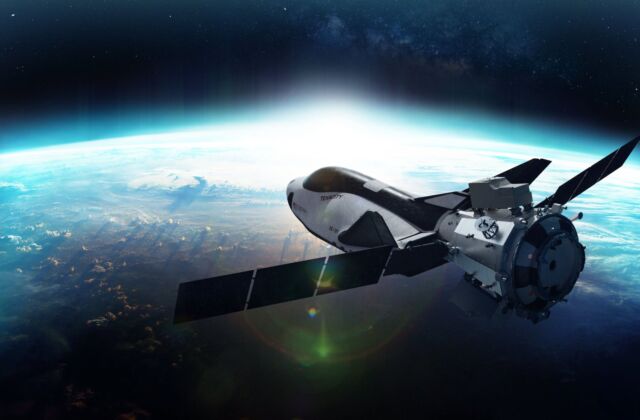
Artist's illustration of Dream Chaser in orbit with its Shooting Star cargo module.
Sierra Space
NASA engineers are reviewing Sierra Space data products, and government and contractor teams are performing joint tests to ensure it's safe for Dream Chaser to approach the space station, home to seven people. Wise said Sierra Space is in Phase 3 of NASA's three-part safety review process.
"We just finished up a major milestone where we and NASA looked at all the flight control products for both Dream Chaser and the ISS," Vice said. He told Ars he doesn't expect any hangups in NASA's reviews as Sierra Space closes in on launch.
When it finally reaches orbit, Dream Chaser will go through several more technical gates before NASA gives the green light to approach the space station.
NASA wants to ensure the spacecraft can maintain control and respond to emergency commands from the space station crew. Assuming it meets those requirements, the spaceplane will fly underneath the station and approach tail-first from below, then halt a little more than 30 feet (10 meters) from the complex, close enough for the Canadian robotic arm to reach out, grapple it, and berth it an open port.
“There are going to be a series of challenges. We're a first flight of a new design of a spacecraft," said Jeff Davis, Sierra Space's lead flight director for the first Dream Chaser test flight. "I have full confidence that United Launch Alliance will deliver us safely into a 200 nautical mile orbit, and then our spacecraft has to do its thing."
We have a whole series of demonstrations we have to do," Davis said. "Just knowing that ISS has human beings onboard, and we're a big heavy spacecraft that's approaching them, is a lot of responsibility."
After a 45-day stay at the space station, Dream Chaser will head back to Earth, aiming to return to the old space shuttle landing strip in Florida. A prototype of the Dream Chaser already tested the spaceplane's autonomous approach and landing algorithms during a drop test over California in 2017.
The Dream Chaser story
Sierra Space and its parent company, Sierra Nevada, have pursued the Dream Chaser spaceplane concept for 15 years. Before that, the program originated in a commercial space startup called SpaceDev, which Sierra Nevada purchased in 2008. Going back further, Dream Chaser's shape is based on the HL-20 lifting body design developed by NASA's Langley Research Center more than 30 years ago.
But that's not the whole story. Dream Chaser's origin can be traced to the Soviet Union, which launched a lifting body named BOR-4 into space several times in the early 1980s. This was a sub-scale model of a spaceplane the Soviets studied since the 1960s and a precursor to the Russian Buran space shuttle. After one of the BOR-4 test flights, an Australian military aircraft took photos of the spaceplane as it was recovered in the Indian Ocean. The Australians shared these images with US intelligence officials, who turned to NASA to help them understand what they were seeing.
NASA researchers used the pictures to reverse-engineer the BOR-4 as the basis for a concept called the HL-20. The HL-20 never flew, but NASA was briefly interested in it as an alternative to the space shuttle for crew transportation after the space shuttle Challenger accident. In 2006, SpaceDev licensed the HL-20 concept from NASA as the starting point for the commercial Dream Chaser.
Once Sierra Nevada took control of the program, after its acquisition of SpaceDev, the company proposed Dream Chaser for NASA's commercial crew program to fly astronauts to and from the space station. It was one of NASA's three finalists.
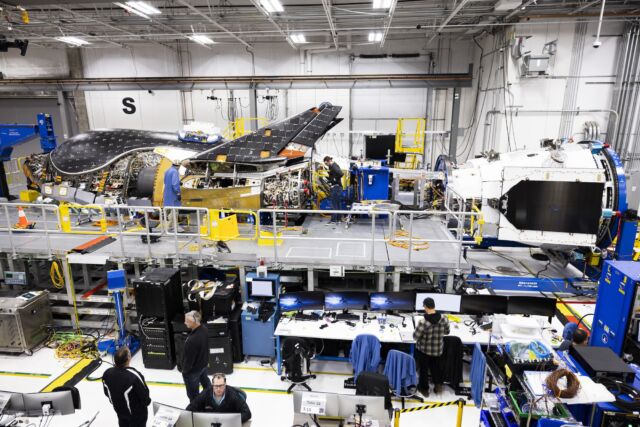
On October 24, Sierra Space moved the Shooting Star cargo module into position behind the
Dream Chaser spaceplane for checkouts before shipment to Ohio for environmental testing.
Shay Saldana/Sierra Space
In 2014, NASA selected Boeing and SpaceX and awarded each company multibillion-dollar contracts to finish developing their Starliner and Crew Dragon capsules. SpaceX has now launched 11 human spaceflight missions. Boeing's Starliner is languishing and still hasn't flown any astronauts.
Sierra Nevada revamped the Dream Chaser program as a cargo-only spacecraft, temporarily ditching the human-rated design. Gone were the cockpit, windows, and docking mechanism for Dream Chaser to link up with the space station on its own. The company saw another opportunity to win NASA support when the agency announced it would select a third contractor to deliver cargo to the space station, alongside incumbents SpaceX and Northrop Grumman, which started flying equipment to the orbiting outpost a decade ago.
The bet paid off. In 2016, NASA selected Sierra Nevada to join SpaceX and Northrop Grumman on the agency's roster of cargo transportation providers. This was a huge win for Sierra Nevada, which has wealthy owners, but it was not equal to the fortune of Elon Musk or the investor base of a defense contractor like Northrop Grumman. It gave Sierra Nevada a sorely needed anchor customer.
NASA's fixed-price service contract covers seven Dream Chaser missions to resupply the space station and return cargo to Earth. The space agency hasn't released the exact value of the contract, citing the competitive nature of the commercial resupply program, but NASA procurement databases show the agency has obligated $1.2 billion to date to Sierra Space for the Dream Chaser cargo program. This doesn't include the more than $350 million NASA provided to Sierra Nevada years ago for the crew variant of Dream Chaser.
“An invention per week”
When NASA awarded Sierra Nevada the Dream Chaser cargo contract, the company targeted 2019 for the first flight to the space station. It's now five years late. Vice said one of the reasons for the delay was the COVID pandemic, which strained supply chains across the space industry. Parts came in and out of sequence, forcing managers to continually change the steps to put Dream Chaser together.
"COVID really slowed us down with the supply chain," he said. "We are now almost totally vertically integrated as a company so we don’t have those kinds of challenges in the future.”
Sierra Space builds its own thrusters, heat shield tiles, solar arrays, and the bulk of the spacecraft's wiring harnesses. "We really have thought about where there were bottlenecks, and we've eliminated those bottlenecks by bringing the work in-house," Vice said. "What we found almost immediately is we can move faster, make products much cheaper, and we don’t have that risk.”
Vice singled out Dream Chaser's propulsion system as one of the program's major technical hurdles. The spacecraft has 26 small rocket engines, each capable of operating at three discrete levels of thrust for fine control or more significant orbit adjustments. Uniquely in the space industry, these thrusters consume a mix of kerosene and hydrogen peroxide propellants rather than toxic hypergolic propellants that ignite on contact with one another.
"We wanted to have a fuel system that was green instead of using hypergolics, so we could land it on a runway and we could walk up to the vehicle without being in hazmat suits," Vice said. "That was hard, I have to say."
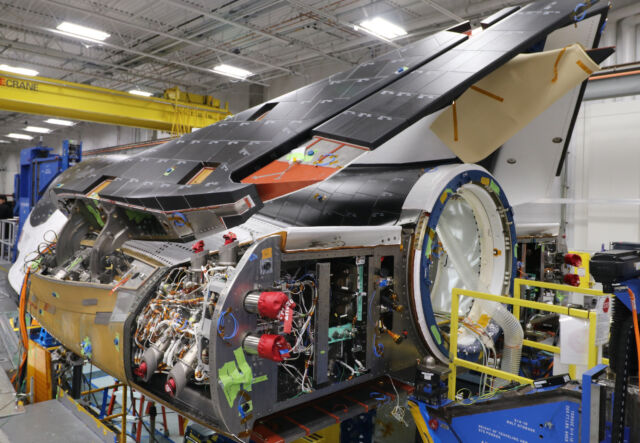
Dream Chaser's wings are folded in this image, which shows elements of the spacecraft's
propulsion system and pressurized cargo tunnel.
Stephen Clark/Ars Technica
Dream Chaser is designed to fly in orbit for up to six months. A limiting factor in the spacecraft's operating life is its use of hydrogen peroxide propellant.
"We are now the world’s experts on hydrogen peroxide, decomposition of hydrogen peroxide, contamination of systems, pumps, valves, lines," Vice said. Hydrogen peroxide is corrosive to many metals and is prone to decompose into water and oxygen.
"We are experts on zirconium," Vice added. Zirconium is resistant to the corrosive effects of hydrogen peroxide and is one of the few metals whose ions do not catalyze hydrogen peroxide's decomposition reaction, according to ATI, a producer of specialty metals.
"There was, it seemed like, an invention per week to make a green vehicle, but we did it," Vice said.
Going forward, Vice said he may decide to bring more supplier work under Sierra Space's roof. He's considering what to do about an agreement announced last year for Spirit AeroSystems to help Sierra Space produce Shooting Star cargo modules. "We continue to evaluate what we want to outsource and what we want to insource, and we'll see where that ultimately goes."
Lockheed Martin is one supplier Sierra Space has counted on. The aerospace and defense juggernaut built the composite primary structure for Dream Chaser at the plant where it assembles F-35 fighter jets. Lockheed Martin has delivered a second bare Dream Chaser structure, which sits a few dozen feet away from the Tenacity spaceplane.
Once Tenacity is out the door, Sierra Space's technicians will start work on the second spacecraft's secondary structure and install tubing, harnesses, and avionics. It will take about two years to fully outfit the second cargo spaceplane, designated DC-102, and Sierra Space projects will cost half as much as the first one, according to Vice. That will handle the demand for at least 30 cargo missions, whether they go to the International Space Station or future commercial space stations or fly as standalone missions for private or government customers.
In the longer term, Sierra Space is studying how to make the Shooting Star cargo section recoverable and reusable. One idea, Vice said, is to add an inflatable heat shield to try to get the cargo module back to the ground intact.
"We’re doing a series of tests on this technology," Vice said. "We’ll start small. We’ll be launching things up and bringing small stuff back, and we’ll scale to (full) size and we’ll see if it works. If it does, it’s a complete game changer because even on (SpaceX's) Dragon, the trunk of Dragon gets burned up every time. We took a step back and said, 'Can we reuse the entire system?'"
Sierra’s lofty ambitions
The real dream, however, is to turn Dream Chaser into a transporter for people, a second version of the spaceplane that Sierra Space calls the DC-200.
"Right now, we’re focused on getting a crew Dream Chaser ready in the ’26 timeframe," Vice said. "There’s still a lot of work to do on the DC-200, but we’re still very focused on that."
The company's work on the crew version of Dream Chaser is coming out of its own private coffers. Sierra Space has raised $1.7 billion from private investors, primarily equity and venture capital funds, since spinning off from Sierra Nevada in 2021. The company reported a valuation of $5.3 billion last month, with $3.4 billion in "active contracts."
Vice said Sierra Space is "heavy into the design phase" of the human-rated Dream Chaser. "Right now, the focus for us is how to we really think about the abort system."
A crew-capable version of Dream Chaser would fly exposed to the aerodynamic airflow during launch, without the protection of a rocket's payload fairing. "We're trying to think very differently about how to do an abort system that's not like anything that's been done before, so it's not so expensive and time-consuming," Vice said. He declined to offer additional details about the launch abort system, which would be required to separate the spaceplane from a failing rocket.
While Dream Chaser is Sierra Space's most famous product, the company is also working on inflatable habitats that could be used to build future commercial space stations. Sierra Space has partnered with Blue Origin, Jeff Bezos's space company, on a space station concept known as Orbital Reef. This is one of several private space stations under study to follow the International Space Station, which is due for retirement in 2030.
But recent reports, including from Ars, have suggested that lead partner Blue Origin may be losing interest in a low-Earth orbit space station. CNBC reported last month that the Blue Origin-Sierra Space partnership was "on rocky footing." A report from Reuters said Blue Origin has reassigned personnel from the space station program.
Vice pushed back on those reports Monday: "I think it was a lot in the press over nothing. I feel very good that we have a strong relationship with Blue Origin."
Whether Blue Origin keeps its interest in a space station or not, Sierra Space views a commercial platform in low-Earth orbit as central to the company's long-term strategy. It sounds like Vice is full steam ahead in this area.
"The real beauty of our approach at Sierra Space is we’re building the entire platform going forward, a commercial platform," Vice said. "So we build both the transportation systems and the in-space destinations. Of course, Dream Chaser is going to provide cargo and crew to our commercial station. That's the way that we think about our strategy. Instead of relying on who else builds the follow-on to the ISS, it’s us.”
Source




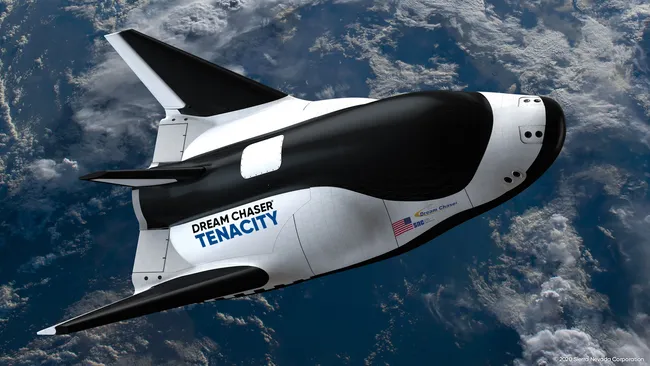
3175x175(CURRENT).thumb.jpg.b05acc060982b36f5891ba728e6d953c.jpg)



Recommended Comments
There are no comments to display.
Join the conversation
You can post now and register later. If you have an account, sign in now to post with your account.
Note: Your post will require moderator approval before it will be visible.